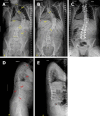Surgical advances in the treatment of neuromuscular scoliosis
- PMID: 24829875
- PMCID: PMC4017305
- DOI: 10.5312/wjo.v5.i2.124
Surgical advances in the treatment of neuromuscular scoliosis
Abstract
Neuromuscular disorders are a group of diseases affecting the neuro-musculo-skeletal system. Children with neuromuscular disorders frequently develop progressive spinal deformities with cardio-respiratory compromise in the most severe cases. The incidence of neuromuscular scoliosis is variable, inversely correlated with ambulatory abilities and with a reported risk ranging from 80% to 100% in non-ambulatory patients. As surgical and peri-operative techniques have improved, more severely affected children with complex neuromuscular deformities and considerable co-morbidities are now believed to be candidates for extensive surgery for spinal deformity. This article aimed to provide a comprehensive review of how neuromuscular spinal deformities can affect normal spine balance and how these deformities can be treated with segmental instrumentation and sub-laminar devices. Older concepts have been integrated with newer scientific data to provide the reader with a basis for better understanding of how treatment of neuromuscular scoliosis has evolved over the past few decades. Recent advances, as well as challenges that remain to be overcome, in the surgical treatment of neuromuscular curves with sub-laminar devices and in the management of post-operative infections are outlined.
Keywords: Luque rod; Neuromuscular scoliosis; Sub-laminar bands; Surgery; Unit rod.
Figures


References
-
- Madigan RR, Wallace SL. Scoliosis in the institutionalized cerebral palsy population. Spine (Phila Pa 1976) 1981;6:583–590. - PubMed
-
- Comstock CP, Leach J, Wenger DR. Scoliosis in total-body-involvement cerebral palsy. Analysis of surgical treatment and patient and caregiver satisfaction. Spine (Phila Pa 1976) 1998;23:1412–1424; discussion 1412-1424. - PubMed
-
- Saito N, Ebara S, Ohotsuka K, Kumeta H, Takaoka K. Natural history of scoliosis in spastic cerebral palsy. Lancet. 1998;351:1687–1692. - PubMed
-
- Bowen RE, Abel MF, Arlet V, Brown D, Burton DC, D’Ambra P, Gill L, Hoekstra DV, Karlin LI, Raso J, et al. Outcome assessment in neuromuscular spinal deformity. J Pediatr Orthop. 2012;32:792–798. - PubMed
-
- Lonstein JE, Koop SE, Novachek TF, Perra JH. Results and complications after spinal fusion for neuromuscular scoliosis in cerebral palsy and static encephalopathy using luque galveston instrumentation: experience in 93 patients. Spine (Phila Pa 1976) 2012;37:583–591. - PubMed
Publication types
LinkOut - more resources
Full Text Sources
Other Literature Sources
Research Materials
Miscellaneous

